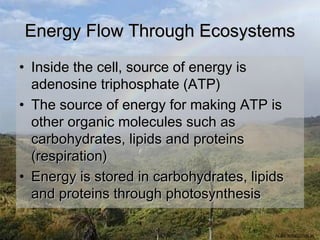
02 Energy Flow through Ecosystems
- 1. Energy Flow Through Ecosystems • Inside the cell, source of energy is adenosine triphosphate (ATP) • The source of energy for making ATP is other organic molecules such as carbohydrates, lipids and proteins (respiration) • Energy is stored in carbohydrates, lipids and proteins through photosynthesis ALBIO9700/2006JK
- 2. Energy flow ALBIO9700/2006JK
- 3. First Trophic Second Trophic Third Trophic Fourth Trophic Level Level Level Level Producers Primary Secondary Tertiary (plants) consumers consumers consumers (herbivores) (carnivores) (top carnivores) Heat Heat Heat Solar energy Heat Heat Heat Heat Detritivores Heat (decomposers and detritus feeders) ALBIO9700/2006JK
- 4. Heat Tertiary Heat consumers Decomposers (human) Heat 10 Secondary consumers (perch) Heat 100 Primary 1,000 consumers (zooplankton) Heat 10,000 Producers Usable energy (phytoplankton) Available at Each tropic level (in kilocalories) ALBIO9700/2006JK
- 5. • Producers – autotrophic organisms; organisms that obtain its food from inorganic sources by photosynthesis or chemosynthesis • Consumers – heterotrophic organisms; organisms that obtain its food in organic form, either directly or indirectly from that which has been synthesised by producers • Decomposers/Detritivores – feed on detritus (dead organisms and waste material, such as dead leaves, faeces and urine) ALBIO9700/2006JK
- 6. Scavengers Decomposers Termite Bark beetle Carpenter and engraving ant carpenter Long- horned galleries ant work Dry rot fungus beetle holes Wood reduced to Mushroom powder Time Powder broken down by decomposers progression into plant nutrients in soil ALBIO9700/2006JK
- 8. Food chains and food webs • Food chain – the way in which energy flows from producer to consumers • Food web – inter-relationships between many food chains • Trophic level – the level in a food chain at which an organism feeds ALBIO9700/2006JK
- 9. Arrows indicate the direction in which the energy flows ALBIO9700/2006JK
- 10. Food Web ALBIO9700/2006JK
- 11. Blue whale Humans Sperm whale Crabeater Elephant seal seal Killer whale Leopard seal Adelie penguins Emperor penguin Squid Petrel Fish Carnivorous plankton Krill Herbivorous plankton Phytoplankton ALBIO9700/2006JK
- 12. • Herbivores – are always primary consumers • Carnivores – feed at several different trophic levels in different food chains • Omnivores – animals which regularly feed as both primary and higher-level consumers ALBIO9700/2006JK
- 13. Energy loss along food chains • Energy is lost as heat when energy is transferred from one form, or from one system, to another • Only small percentage of sunlight is converted into chemical energy because: – Some sunlight misses leaves – Some sunlight reflected from surfaces of leaves – Some sunlight passes through leaves – Chlorophyll only absorbs certain wavelengths of light – Energy losses as energy absorbed by chlorophyll is transferred to carbohydrates during photosynthesis ALBIO9700/2006JK
- 14. • Almost half of the chemical potential energy stored by plants is used by the plants themselves (released through respiration/used for active transport) • Losses between plants and primary consumer: – Not all parts of plants available to be eaten – Not all parts eaten are digestible – Energy losses as heat within consumer’s digestive system • Similar losses occur at each trophic level ALBIO9700/2006JK
- 15. Productivity • The rate at which plants convert light into chemical potential energy – productivity or primary productivity • Kilojoules of energy transferred per square metre per year (kJ m-2 year-1) • Gross primary productivity – total quantity of energy converted by plants in this way • Net primary productivity – energy which remains as chemical energy after the plants have supplied their own needs in respiration ALBIO9700/2006JK
Hinweis der Redaktion
- Figure 3.17 Natural capital: a food chain. The arrows show how chemical energy in food flows through various trophic levels in energy transfers; most of the energy is degraded to heat, in accordance with the second law of thermodynamics.
- Figure 3.19 Natural capital: generalized pyramid of energy flow showing the decrease in usable energy available at each succeeding trophic level in a food chain or web. In nature, ecological efficiency varies from 2% to 40%, with 10% efficiency being common. This model assumes a 10% ecological efficiency (90% loss in usable energy to the environment, in the form of low-quality heat) with each transfer from one trophic level to another. QUESTION: Why is it a scientific error to call this a pyramid of energy?
- Figure 3.13 Natural capital: various scavengers (detritivores) and decomposers (mostly fungi and bacteria) can “ feed on ” or digest parts of a log and eventually convert its complex organic chemicals into simpler inorganic nutrients that can be taken up by producers.
- Figure 3.18 Natural capital: a greatly simplified food web in the Antarctic. Many more participants in the web, including an array of decomposer organisms, are not depicted here.
